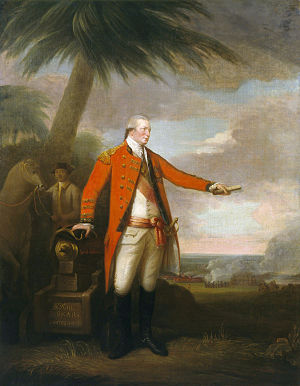TheBattle of Buxarwas fought between 22 and 23 October 1764, between the forces of theBritish East India Company,under the command of MajorHector Munro,and the combined armies ofBalwant Singh,Maharaja of theBanaras State;Mir Qasim,Nawab of Bengal;Shuja-ud-Daula,Nawab of Awadh;andShah Alam II,Emperor of theMughal Empire.[4]
| Battle of Buxar | |||||||
|---|---|---|---|---|---|---|---|
| Part of theSeven Years' War | |||||||
 A portrait ofSir Hector Munrowith the battle in the background | |||||||
| |||||||
| Belligerents | |||||||
|
|
| ||||||
| Commanders and leaders | |||||||
|
|
| ||||||
| Strength | |||||||
| 17,072 | 40,112 | ||||||
| Casualties and losses | |||||||
|
289 killed 499 wounded 85 missing[2][3] |
2,000 killed 4,000 wounded[2] | ||||||
The battle was fought atBuxar,a "strong fortified town" within the territory ofBihar,located on the banks of theGanges riverabout 130 kilometres (81 mi) west ofPatna;it was a challenging victory for the BritishEast India Company.The war was brought to an end by theTreaty of Allahabadin 1765.[5]The defeated Indian rulers were forced to sign the treaty, granting the East India CompanyDiwanirights, which allowed them to collect revenue from the territories ofBengal,Bihar,andOrissaon behalf of the Mughal emperor.
The Battle
editThe British engaged in the fighting numbered 17,072[6]comprising 1,859 British regulars, 5,297 Indiansepoysand 9,189 Indiancavalry.The alliance army's numbers were estimated to be over 40,000, but they were still defeated by the British. A lack of basic co-ordination between the three disparate allies is seen as responsible for their decisive defeat.[citation needed]
Mirza Najaf Khancommanded the right flank of the Mughal imperial army and was the first to advance his forces against MajorHector Munroat daybreak; the British lines formed within twenty minutes and reversed the advance of theMughals.According to the British,DurraniandRohillacavalry were also present and fought during the battle in various skirmishes. But by midday, the battle was over andShuja-ud-Daulablew up large tumbrils and three massive magazines of gunpowder.
Munro divided his army into various columns and particularly pursued the MughalGrand VizierShuja-ud-Daula,theNawab of Awadh,who responded by blowing up his boat-bridge after crossing the river, thus abandoning theMughal EmperorShah Alam IIand members of his own regiment.Mir Qasimalso fled with his 3 million rupees worth of gemstones and later died in poverty in 1777. Mirza Najaf Khan reorganised formations aroundShah Alam II,who retreated and then chose to negotiate with the victorious British.[7]
The historianJohn William Fortescueclaimed that the British casualties totalled 847: 39 killed and 64 wounded from the European regiments and 250 killed, 435 wounded and 85 missing from the East India Company's sepoys.[2]He also claimed that the three Indian allies suffered 2,000 dead and that many more were wounded.[2]Another source says that there were 69 European and 664 sepoy casualties on the British side and 6,000 casualties on the Mughal side.[3]The victors captured 133 pieces of artillery and over 1 million rupees of cash. Immediately after the battle, Munro decided to assist theMarathas,who were described as a "warlike race", well known for their relentless rivalry and unwavering hatred towardsMughal Empire,Durrani Empire,Rohilla Chieftaincies,differentNawabsof thesubcontinent(most notably,Nawab of BengalandNawab of Awadh),Nizam of Hyderabadand short livedSultanate of Mysore.
According to onebrigadier-generalH. Biddulph, "the European infantry was composed of the Bengal European Battalion, two weak companies of the Bombay European Battalion, and small detachments of Marines and of H.M. 84th, 89th and 96th Regiments. The only officers killed were Lt. Francis Spilsbury of the 96th Foot and Ensign Richard Thompson of the Bengal European Battalion."[8][9]
Aftermath
editThe Battle of Buxar had far-reaching consequences that reshaped the political landscape of colonial India. Its aftermath witnessed significant shifts in power dynamics and set the stage for British dominance in the Bengal region. Following their victory over the combined forces of theNawab of Bengal,theNawab of Awadh,and theMughal Emperor—the three main scions—theBritish East India Companyemerged as the preeminent power in Bengal. The battle was the beginning of the end for the Mughal Empire's political control, as the Company continued to consolidate its influence over vast territories.[7]However, this rise to power came with various challenges, especially from thezamindars of Bihar.[10]
Mir Qasimdisappeared into impoverished obscurity.Shah Alam IIsurrendered himself to the British, andShuja-ud-Daulafled west hotly pursued by the victors. The whole Ganges valley lay at the company's mercy; Shuja-ud-Daula eventually surrendered.[11]In 1765, the British East India Company was granted the right to collect taxes from Bengal-Bihar. Eventually, in 1772, the East India company abolished local rule and took complete control of the province of Bengal-Bihar.[12]The battle exposed the inherent weaknesses and divisions among the Indian rulers. The lack of unity and coordination between the Nawabs and the Mughal Emperor made it easier for the British to defeat them. This further exacerbated the fragmentation of political power in India and paved the way for British rule on the subcontinent.
Gallery
editSee also
editReferences
edit- ^abSen, Sailendra Nath (2009).History Of The Freedom Movement In India (1857–1947).New Age International. p. 2.ISBN9788122425765.
- ^abcdJohn William(2004).Fortescue's History of the British Army.Vol. 2. Naval & Military Press.ISBN978-1-84342-715-5.
- ^abBlack, Jeremy (28 March 1996). Wyse, Liz (ed.).The Cambridge Illustrated Atlas of Warfare: Renaissance to Revolution, 1492–1792.Vol. 2.Cambridge:Cambridge University Press. p. 160.ISBN978-0-521-47033-9.
- ^Parshotam Mehra (1985).A Dictionary of Modern History (1707–1947).Oxford University Press.ISBN0-19-561552-2.
- ^Zaman, Faridah (2015)."Colonizing the Sacred: Allahabad and the Company State, 1797–1857".The Journal of Asian Studies.74(2): 347–367.doi:10.1017/S0021911815000017.JSTOR43553588.
- ^Cust, Edward(1858).Annals of the Wars of the Eighteenth Century: 1760–1783.Vol. III. London: Mitchell's Mibdglitiry Library. p. 113.
- ^abSingh, Sonal (2017)."Micro-history Lost in a Global Narrative? Revisiting the Grant of the" Diwani "to the English East India Company".Social Scientist.45(3/4): 41–51.JSTOR26380344.
- ^Biddulph, H (1941)."571. The Battle of Buxar, 1764".Journal of the Society for Army Historical Research.29(79). Society for Army Historical Research: 174.JSTOR44220683.
- ^Cadell, P.R. (1941)."560. The Battle of Buxar, 1764".Journal of the Society for Army Historical Research.20(78). Society for Army Historical Research: 113.JSTOR44228260.
- ^Maharatna, Paramita (2012)."The Zamindars of Bihar: Their Resistance to Colonial Rule between 1765-1781".Proceedings of the Indian History Congress.73.Indian History Congress: 1435.JSTOR44156363.
- ^Bryant, G.J. (2004)."Asymmetric Warfare: The British Experience in Eighteenth-Century India".The Journal of Military History.68(2): 431–469.doi:10.1353/jmh.2004.0019.JSTOR3397474.
- ^Keay, John(8 July 2010).The Honourable Company.London: HarperCollins UK. p. 374.ISBN978-0-00-739554-5.